Characterisation of Two Vineyards in Mexico Based on Sentinel-2 and Meteorological Data
Abstract
1. Introduction
- To assess the dynamics of the main meteorological elements of the two vineyards.
- To assess the phenology of the two vineyards through spectral vegetation indices (NDVI and MSAVI).
- To obtain thermal indices of the two vineyards and compare them with other wine-producing regions.
- To relate meteorological information to spectral indices.
2. Materials and Methods
2.1. Study Area
2.2. Phenological Stages
2.3. Remote Sensing and Reanalysis Data
2.4. Meteorological Data from Automatic Weather Stations (AWSs)
2.5. Methods
2.5.1. Spectral Indices
Normalized Difference Vegetation Index (NDVI)
Modified Soil-Adjusted Vegetation Index (MSAVI)
2.5.2. Thermal Indices
Winkler Index (WI)
Huglin Index (HI)
Cold Nights Index (CI)
Growing Season Temperature
2.6. Statistical Analysis
3. Results
3.1. Dynamics of Meteorological Elements of the Vineyards
3.2. Phenological Development for the Two Vineyards through NDVI and MSAVI
3.3. Relationship between NDVI and Precipitation
3.4. Classification according to Thermal or Bioclimatic Indices
4. Discussion
4.1. Spectral Indices and Phenology
4.2. Thermal Indices
4.3. Meteorology, Dynamics, and Relations
5. Summary and Conclusions
Author Contributions
Funding
Data Availability Statement
Acknowledgments
Conflicts of Interest
References
- OIV International Organisation of Vine and Wine. Available online: https://www.oiv.int/ (accessed on 16 October 2023).
- Yu, Y.; Rodrigo-Comino, J. Analyzing Regional Geographic Challenges: The Resilience of Chinese Vineyards to Land Degradation Using a Societal and Biophysical Approach. Land 2021, 10, 227. [Google Scholar] [CrossRef]
- Uvayvino.Org. Available online: https://uvayvino.org.mx/ (accessed on 16 October 2023).
- Cruz-de Aquino, M.A.d.l.; Martínez-Peniche, R.A.; Becerril-Román, A.E.; Chávaro-Ortiz, M.d.S. Physical and Chemical Characterization of Red Wines Produced in Querétaro. Rev. Fitotec. Mex. 2012, 35, 61–67. [Google Scholar]
- Sun, Q.; Granco, G.; Groves, L.; Voong, J.; Van Zyl, S. Viticultural Manipulation and New Technologies to Address Environmental Challenges Caused by Climate Change. Climate 2023, 11, 83. [Google Scholar] [CrossRef]
- Weiss, M.; Jacob, F.; Duveiller, G. Remote Sensing for Agricultural Applications: A Meta-Review. Remote Sens. Environ. 2020, 236, 111402. [Google Scholar] [CrossRef]
- Palacios-Orueta, A.; Huesca, M.; Whiting, M.L.; Litago, J.; Khanna, S.; Garcia, M.; Ustin, S.L. Derivation of Phenological Metrics by Function Fitting to Time-Series of Spectral Shape Indexes AS1 and AS2: Mapping Cotton Phenological Stages Using MODIS Time Series. Remote Sens. Environ. 2012, 126, 148–159. [Google Scholar] [CrossRef]
- Cicuéndez, V.; Rodríguez-Rastrero, M.; Huesca, M.; Uribe, C.; Schmid, T.; Inclán, R.; Litago, J.; Sánchez-Girón, V.; Merino-de-Miguel, S.; Palacios-Orueta, A. Assessment of Soil Respiration Patterns in an Irrigated Corn Field Based on Spectral Information Acquired by Field Spectroscopy. Agric. Ecosyst. Environ. 2015, 212, 158–167. [Google Scholar] [CrossRef]
- Viña, A.; Gitelson, A.A.; Nguy-Robertson, A.L.; Peng, Y. Comparison of Different Vegetation Indices for the Remote Assessment of Green Leaf Area Index of Crops. Remote Sens. Environ. 2011, 115, 3468–3478. [Google Scholar] [CrossRef]
- Tucker, C.J. Red and Photographic Infrared Linear Combinations for Monitoring Vegetation. Remote Sens. Environ. 1979, 8, 127–150. [Google Scholar] [CrossRef]
- Huete, A.; Didan, K.; Miura, T.; Rodriguez, E.P.; Gao, X.; Ferreira, L.G. Overview of the Radiometric and Biophysical Performance of the MODIS Vegetation Indices. Remote Sens. Environ. 2002, 83, 195–213. [Google Scholar] [CrossRef]
- Qi, J.; Chehbouni, A.; Huete, A.R.; Kerr, Y.H.; Sorooshian, S. A Modified Soil Adjusted Vegetation Index. Remote Sens. Environ. 1994, 48, 119–126. [Google Scholar] [CrossRef]
- Huete, A.R. A Soil-Adjusted Vegetation Index (SAVI). Remote Sens. Environ. 1988, 25, 295–309. [Google Scholar] [CrossRef]
- Hall, A.; Lamb, D.W.; Holzapfel, B.; Louis, J. Optical Remote Sensing Applications in Viticulture—A Review. Aust. J. Grape Wine Res. 2002, 8, 36–47. [Google Scholar] [CrossRef]
- Kazmierski, M.; Glémas, P.; Rousseau, J.; Tisseyre, B. Temporal Stability of Within-Field Patterns of NDVI in Non Irrigated Mediterranean Vineyards. OENO One 2011, 45, 61. [Google Scholar] [CrossRef]
- Puig-Sirera, À.; Antichi, D.; Warren Raffa, D.; Rallo, G. Application of Remote Sensing Techniques to Discriminate the Effect of Different Soil Management Treatments over Rainfed Vineyards in Chianti Terroir. Remote Sens. 2021, 13, 716. [Google Scholar] [CrossRef]
- Badr, G.; Hoogenboom, G.; Davenport, J.; Smithyman, J. Estimating Growing Season Length Using Vegetation Indices Based on Remote Sensing: A Case Study for Vineyards in Washington State. Trans. ASABE 2015, 58, 551–564. [Google Scholar] [CrossRef]
- Zorer, R.; Rocchini, D.; Metz, M.; Delucchi, L.; Zottele, F.; Meggio, F.; Neteler, M. Daily MODIS Land Surface Temperature Data for the Analysis of the Heat Requirements of Grapevine Varieties. IEEE Trans. Geosci. Remote Sens. 2013, 51, 2128–2135. [Google Scholar] [CrossRef]
- Shammi, S.A.; Meng, Q. Use Time Series NDVI and EVI to Develop Dynamic Crop Growth Metrics for Yield Modeling. Ecol. Indic. 2021, 121, 107124. [Google Scholar] [CrossRef]
- Ribeiro, L.F.O.; da Vitória, E.L.; Soprani Júnior, G.G.; Chen, P.; Lan, Y. Impact of Operational Parameters on Droplet Distribution Using an Unmanned Aerial Vehicle in a Papaya Orchard. Agronomy 2023, 13, 1138. [Google Scholar] [CrossRef]
- Gavrilović, M.; Jovanović, D.; Božović, P.; Benka, P.; Govedarica, M. Vineyard Zoning and Vine Detection Using Machine Learning in Unmanned Aerial Vehicle Imagery. Remote Sens. 2024, 16, 584. [Google Scholar] [CrossRef]
- Atencia Payares, L.K.; Tarquis, A.M.; Hermoso Peralo, R.; Cano, J.; Cámara, J.; Nowack, J.; Gómez del Campo, M. Multispectral and Thermal Sensors Onboard UAVs for Heterogeneity in Merlot Vineyard Detection: Contribution to Zoning Maps. Remote Sens. 2023, 15, 4024. [Google Scholar] [CrossRef]
- Cogato, A.; Pagay, V.; Marinello, F.; Meggio, F.; Grace, P.; Migliorati, M.D.A. Assessing the Feasibility of Using Sentinel-2 Imagery to Quantify the Impact of Heatwaves on Irrigated Vineyards. Remote Sens. 2019, 11, 2869. [Google Scholar] [CrossRef]
- Cogato, A.; Meggio, F.; Collins, C.; Marinello, F. Medium-Resolution Multispectral Data from Sentinel-2 to Assess the Damage and the Recovery Time of Late Frost on Vineyards. Remote Sens. 2020, 12, 1896. [Google Scholar] [CrossRef]
- García-gutiérrez, V.; Stöckle, C.; Gil, P.M.; Meza, F.J. Evaluation of Penman–Monteith Model Based on Sentinel-2 Data for the Estimation of Actual Evapotranspiration in Vineyards. Remote Sens. 2021, 13, 478. [Google Scholar] [CrossRef]
- Devaux, N.; Crestey, T.; Leroux, C.; Tisseyre, B. Potential of Sentinel-2 Satellite Images to Monitor Vine Fields Grown at a Territorial Scale. OENO One 2019, 53, 51–58. [Google Scholar] [CrossRef]
- Stolarski, O.; Fraga, H.; Sousa, J.J.; Pádua, L. Synergistic Use of Sentinel-2 and UAV Multispectral Data to Improve and Optimize Viticulture Management. Drones 2022, 6, 366. [Google Scholar] [CrossRef]
- Vélez, S.; Rançon, F.; Barajas, E.; Brunel, G.; Rubio, J.A.; Tisseyre, B. Potential of Functional Analysis Applied to Sentinel-2 Time-Series to Assess Relevant Agronomic Parameters at the within-Field Level in Viticulture. Comput. Electron. Agric. 2022, 194, 106726. [Google Scholar] [CrossRef]
- Giovos, R.; Tassopoulos, D.; Kalivas, D.; Lougkos, N.; Priovolou, A. Remote Sensing Vegetation Indices in Viticulture: A Critical Review. Agriculture 2021, 11, 457. [Google Scholar] [CrossRef]
- Fernandez-Beltran, R.; Baidar, T.; Kang, J.; Pla, F. Rice-Yield Prediction with Multi-Temporal Sentinel-2 Data and 3D CNN: A Case Study in Nepal. Remote Sens. 2021, 13, 1391. [Google Scholar] [CrossRef]
- Phiri, D.; Simwanda, M.; Salekin, S.; Nyirenda, V.; Murayama, Y.; Ranagalage, M. Sentinel-2 Data for Land Cover/Use Mapping: A Review. Remote Sens. 2020, 12, 2291. [Google Scholar] [CrossRef]
- Sustainable Development Goals. Available online: https://sdgs.un.org/goals (accessed on 16 October 2023).
- Jones, G.V. Climate Change in the Western United States Grape Growing Regions. Acta Hortic. 2005, 689, 41–60. [Google Scholar] [CrossRef]
- Karoglan, M.; Telišman Prtenjak, M.; Šimon, S.; Osrečak, M.; Anić, M.; Karoglan Kontić, J.; Andabaka, Ž.; Tomaz, I.; Grisogono, B.; Belušić, A.; et al. Classification of Croatian Winegrowing Regions Based on Bioclimatic Indices. In Proceedings of the XII International Terroir Congress, Zaragoza, Spain, 22 June 2018; p. 01032. [Google Scholar]
- Badr, G.; Hoogenboom, G.; Abouali, M.; Moyer, M.; Keller, M. Analysis of Several Bioclimatic Indices for Viticultural Zoning in the Pacific Northwest. Clim. Res. 2018, 76, 203–223. [Google Scholar] [CrossRef]
- Amerine, M.; Winkler, A. Composition and Quality of Musts and Wines of California Grapes. Hilgardia 1944, 15, 493–675. [Google Scholar] [CrossRef]
- Winkler, A.J. General Viticulture; University of California Press: Berkeley, CA, USA, 1974. [Google Scholar]
- Huglin, P. Nouveau Mode d’évaluation Des Possibilités Héliothermiques d’un Milieu Viticole. Comptes Rendus de l’Académie d’Agriculture; Académie d’agriculture de France: Paris, France, 1978.
- Jones, G.V. Climate and Terroir: Impacts of Climate Variability and Change on Wine. In Fine Wine and Terroir—The Geoscience Perspective; Macqueen, R.W., Meinert, L.D., Eds.; Geological Association of Canada: St John’s, NL, Canada, 2006; pp. 203–216. [Google Scholar]
- Tonietto, J. Les Macroclimats Viticoles Mondiaux et l’influence Du Mésoclimat Sur La Typicité de La Syrah et Du Muscat de Hambourg 447 Dans Le Sud de La France: Méthodologie de Caráctérisation; Ecole Nationale Supérieure Agronomique: Montpellier, France, 1999. [Google Scholar]
- Tonietto, J.; Carbonneau, A. A Multicriteria Climatic Classification System for Grape-Growing Regions Worldwide. Agric. Meteorol. 2004, 124, 81–97. [Google Scholar] [CrossRef]
- Honorio, F.; García-Martín, A.; Moral, F.J.; Paniagua, L.L.; Rebollo, F.J. Spanish Vineyard Classification According to Bioclimatic Indexes. Aust. J. Grape Wine Res. 2018, 24, 335–344. [Google Scholar] [CrossRef]
- del Río, M.S.; Raventós, L.; Garza, V. Zoning of the Querétaro Wine Region. BIO Web Conf. 2023, 68, 01029. [Google Scholar] [CrossRef]
- Beck, H.E.; Zimmermann, N.E.; McVicar, T.R.; Vergopolan, N.; Berg, A.; Wood, E.F. Present and Future Köppen-Geiger Climate Classification Maps at 1-Km Resolution. Sci. Data 2018, 5, 180214. [Google Scholar] [CrossRef] [PubMed]
- European Space Agency. Available online: www.esa.int (accessed on 16 October 2023).
- Farr, T.G.; Rosen, P.A.; Caro, E.; Crippen, R.; Duren, R.; Hensley, S.; Kobrick, M.; Paller, M.; Rodriguez, E.; Roth, L.; et al. The Shuttle Radar Topography Mission. Rev. Geophys. 2007, 45, RG2004. [Google Scholar] [CrossRef]
- Muñoz-Sabater, J.; Dutra, E.; Agustí-Panareda, A.; Albergel, C.; Arduini, G.; Balsamo, G.; Boussetta, S.; Choulga, M.; Harrigan, S.; Hersbach, H.; et al. ERA5-Land: A State-of-the-Art Global Reanalysis Dataset for Land Applications. Earth Syst. Sci. Data 2021, 13, 4349–4383. [Google Scholar] [CrossRef]
- Thornton, M.M.; Shrestha, R.; Wei, Y.; Thornton, P.E.; Kao, S.; Wilson, B.E. Daymet: Daily Surface Weather Data on a 1-Km Grid for North America, Version 4; ORNL DAAC: Oak Ridge, TN, USA, 2020.
- Funk, C.; Peterson, P.; Landsfeld, M.; Pedreros, D.; Verdin, J.; Shukla, S.; Husak, G.; Rowland, J.; Harrison, L.; Hoell, A.; et al. The Climate Hazards Infrared Precipitation with Stations—A New Environmental Record for Monitoring Extremes. Sci. Data 2015, 2, 150066. [Google Scholar] [CrossRef]
- Eos Data Analytics. Available online: https://www.eos.com/ (accessed on 13 September 2023).
- Goldammer, T. The Grape Grower’s Handbook: A Guide to Viticulture for Wine Production; Apex Publishers: Centreville, VA, USA, 2018. [Google Scholar]
- Meyers, J.M.; Vanden Heuvel, J.E. Use of Normalized Difference Vegetation Index Images to Optimize Vineyard Sampling Protocols. Am. J. Enol. Vitic. 2014, 65, 250–253. [Google Scholar] [CrossRef]
- Martínez, A.; Gomez-Miguel, V.D. Vegetation Index Cartography as a Methodology Complement to the Terroir Zoning for Its Use in Precision Viticulture. OENO One 2017, 51, 289. [Google Scholar] [CrossRef]
- Ferro, M.V.; Catania, P.; Miccichè, D.; Pisciotta, A.; Vallone, M.; Orlando, S. Assessment of Vineyard Vigour and Yield Spatio-Temporal Variability Based on UAV High Resolution Multispectral Images. Biosyst. Eng. 2023, 231, 36–56. [Google Scholar] [CrossRef]
- Blanco-Ward, D.; Ribeiro, A.; Barreales, D.; Castro, J.; Verdial, J.; Feliciano, M.; Viceto, C.; Rocha, A.; Carlos, C.; Silveira, C.; et al. Climate Change Potential Effects on Grapevine Bioclimatic Indices: A Case Study for the Portuguese Demarcated Douro Region (Portugal). BIO Web Conf. 2019, 12, 01013. [Google Scholar] [CrossRef]
- Press, W.H. Numerical Recipes 3rd Edition: The Art of Scientific Computing; Cambridge University Press, Ed.; Cambridge University Press: Cambridge, UK, 2007. [Google Scholar]
- Bramley, R.G.V.; Ouzman, J.; Boss, P.K. Variation in Vine Vigour, Grape Yield and Vineyard Soils and Topography as Indicators of Variation in the Chemical Composition of Grapes, Wine and Wine Sensory Attributes. Aust. J. Grape Wine Res. 2011, 17, 217–229. [Google Scholar] [CrossRef]
- Vélez, S.; Rubio, J.A.; Andrés, M.I.; Barajas, E. Agronomic Classification between Vineyards (‘Verdejo’) Using NDVI and Sentinel-2 and Evaluation of Their Wines. Vitis J. Grapevine Res. 2019, 58, 33–38. [Google Scholar] [CrossRef]
- Pádua, L.; Matese, A.; Di Gennaro, S.F.; Morais, R.; Peres, E.; Sousa, J.J. Vineyard Classification Using OBIA on UAV-Based RGB and Multispectral Data: A Case Study in Different Wine Regions. Comput. Electron. Agric. 2022, 196, 106905. [Google Scholar] [CrossRef]
- Laroche-Pinel, E.; Duthoit, S.; Albughdadi, M.; Costard, A.D.; Rousseau, J.; Chéret, V.; Clenet, H. Towards Vine Water Status Monitoring on a Large Scale Using Sentinel-2 Images. Remote Sens. 2021, 13, 1837. [Google Scholar] [CrossRef]
- Ramírez-Juidias, E.; Amaro-Mellado, J.-L.; Leiva-Piedra, J.L.; Mediano-Guisado, J.A. Use of Remote Sensing Techniques to Infer the Red Globe Grape Variety in the Chancay-Lambayeque Valley (Northern Peru). Remote Sens. Appl. 2024, 33, 101108. [Google Scholar] [CrossRef]
- García-Gutiérrez, V.; Meza, F. Modeling Phenology Combining Data Assimilation Techniques and Bioclimatic Indices in a Cabernet Sauvignon Vineyard (Vitis vinifera L.) in Central Chile. Remote Sens. 2023, 15, 3537. [Google Scholar] [CrossRef]
- Coluzzi, R.; Imbrenda, V.; Lanfredi, M.; Simoniello, T. A First Assessment of the Sentinel-2 Level 1-C Cloud Mask Product to Support Informed Surface Analyses. Remote Sens. Environ. 2018, 217, 426–443. [Google Scholar] [CrossRef]
- Nazarova, T.; Martin, P.; Giuliani, G. Monitoring Vegetation Change in the Presence of High Cloud Cover with Sentinel-2 in a Lowland Tropical Forest Region in Brazil. Remote Sens. 2020, 12, 1829. [Google Scholar] [CrossRef]
- Jones, G.V.; Reid, R.; Vilks, A. Climate, Grapes, and Wine: Structure and Suitability in a Variable and Changing Climate. In The Geography of Wine; Dougherty, P., Ed.; Springer: Dordrecht, The Netherlands, 2012; pp. 109–133. [Google Scholar]
- Jones, G.V.; Alves, F. Impact of Climate Change on Wine Production: A Global Overview and Regional Assessment in the Douro Valley of Portugal. Int. J. Glob. Warm. 2012, 4, 383. [Google Scholar] [CrossRef]
- Omazić, B.; Telišman Prtenjak, M.; Bubola, M.; Meštrić, J.; Karoglan, M.; Prša, I. Application of Statistical Models in the Detection of Grapevine Phenology Changes. Agric. Meteorol. 2023, 341, 109682. [Google Scholar] [CrossRef]
- Droulia, F.; Charalampopoulos, I. A Review on the Observed Climate Change in Europe and Its Impacts on Viticulture. Atmosphere 2022, 13, 837. [Google Scholar] [CrossRef]
- Bonifacio, R.; Dugdale, G.; Milford, J.R. Sahelian Rangeland Production in Relation to Rainfall Estimates from Meteosat. Int. J. Remote Sens. 1993, 14, 2695–2711. [Google Scholar] [CrossRef]
- De la Casa, A.; Ovando, G. Relación Entre La Precipitación e Índices de Vegetación Durante El Comienzo Del Ciclo Anual de Lluvias En La Provincia de Córdoba, Argentina. RIA Rev. Investig. Agropecu. 2006, 35, 67–85. [Google Scholar]
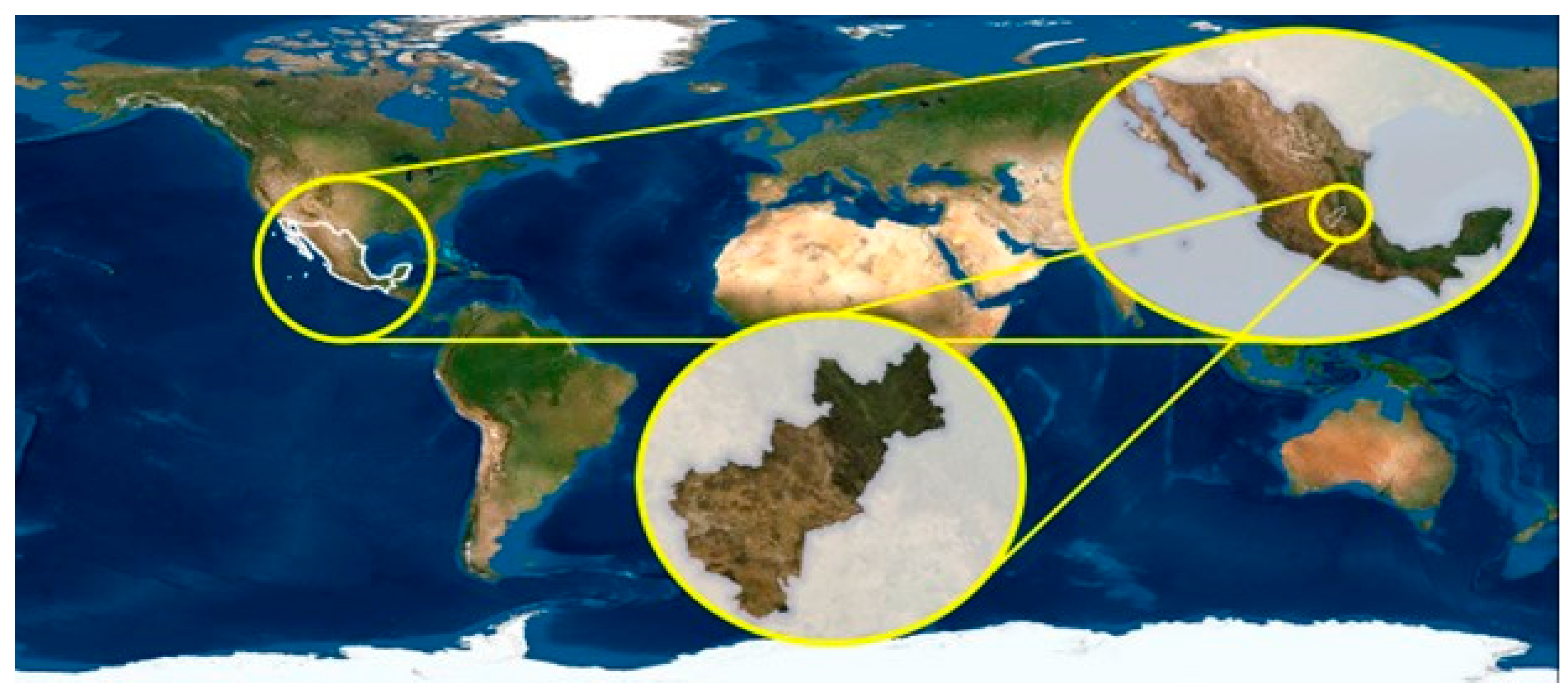


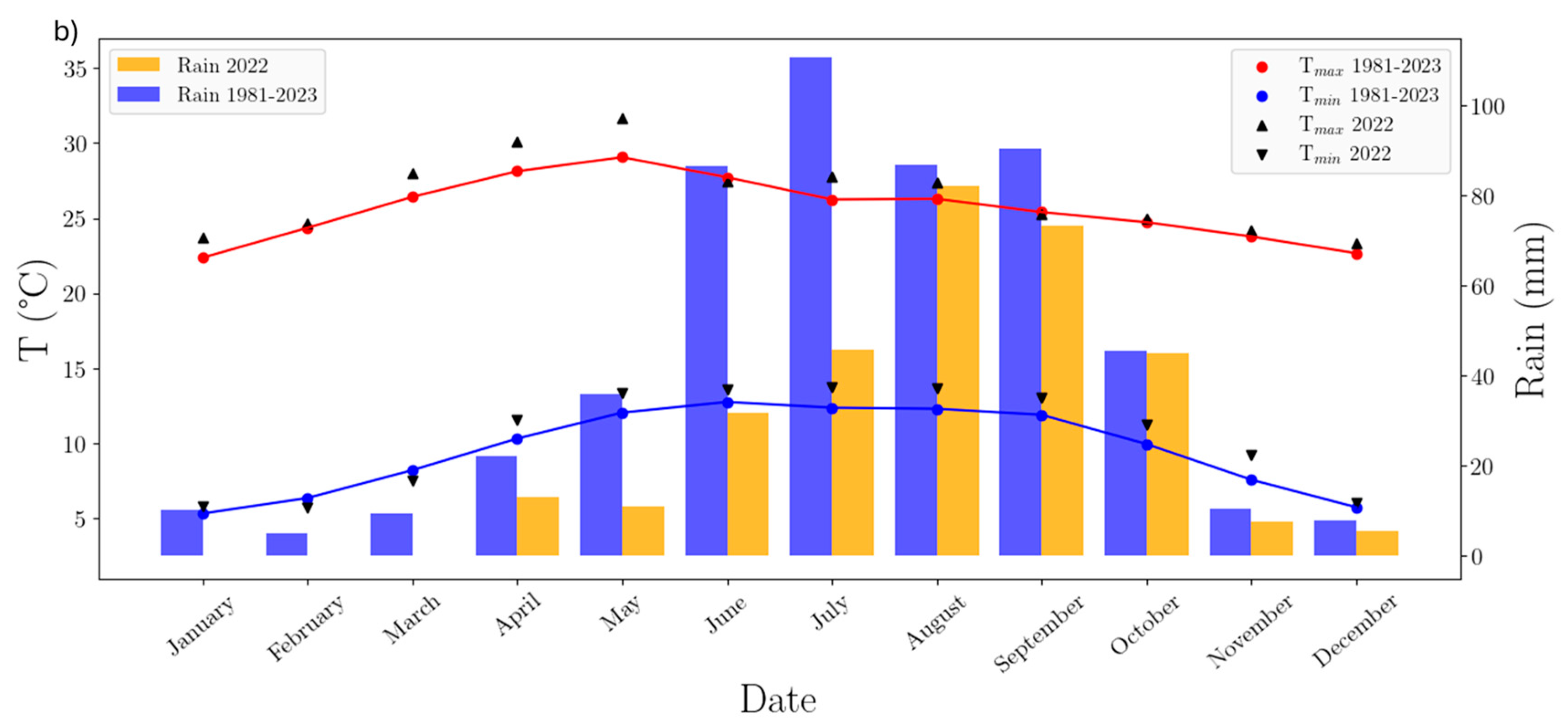


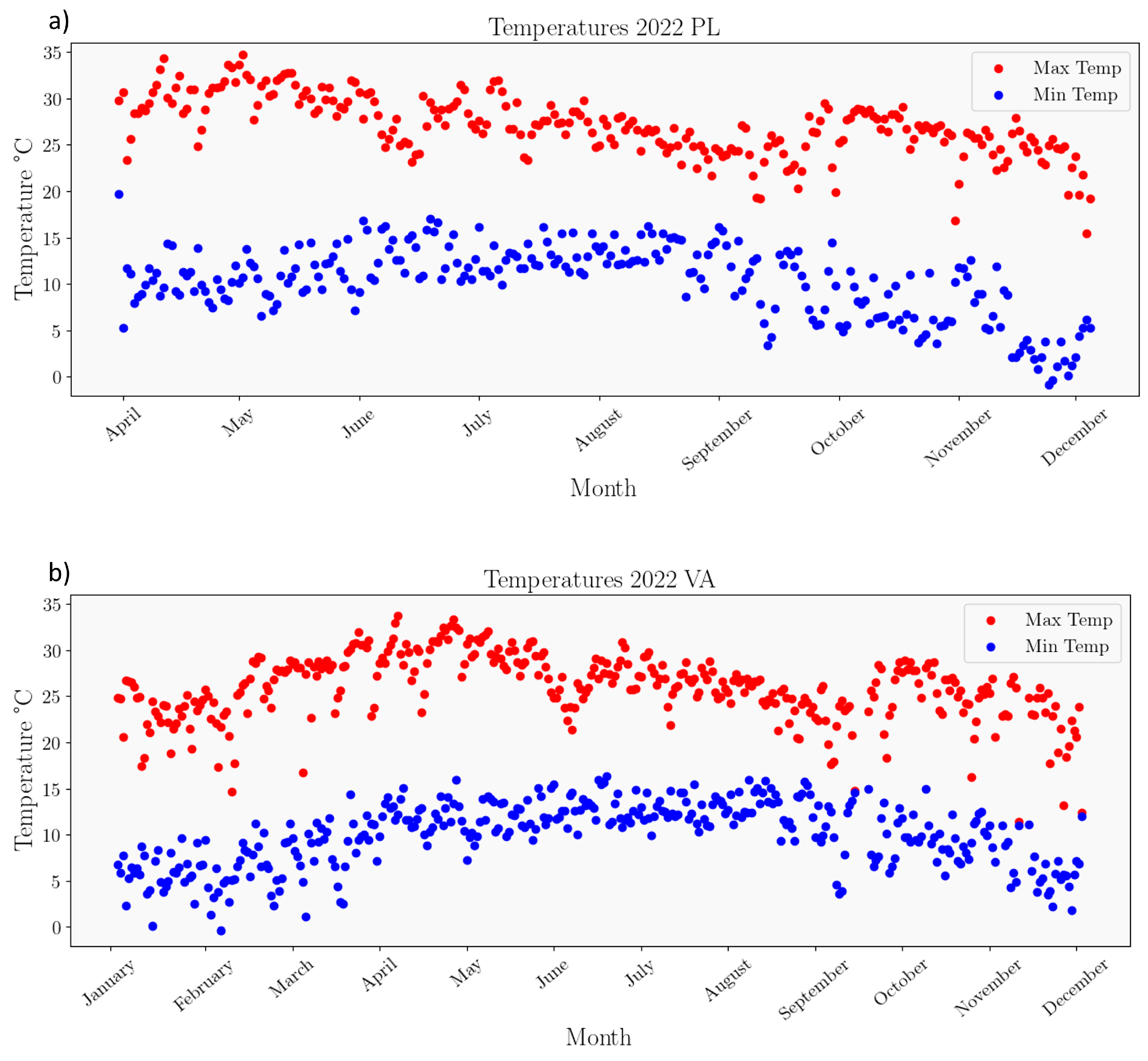

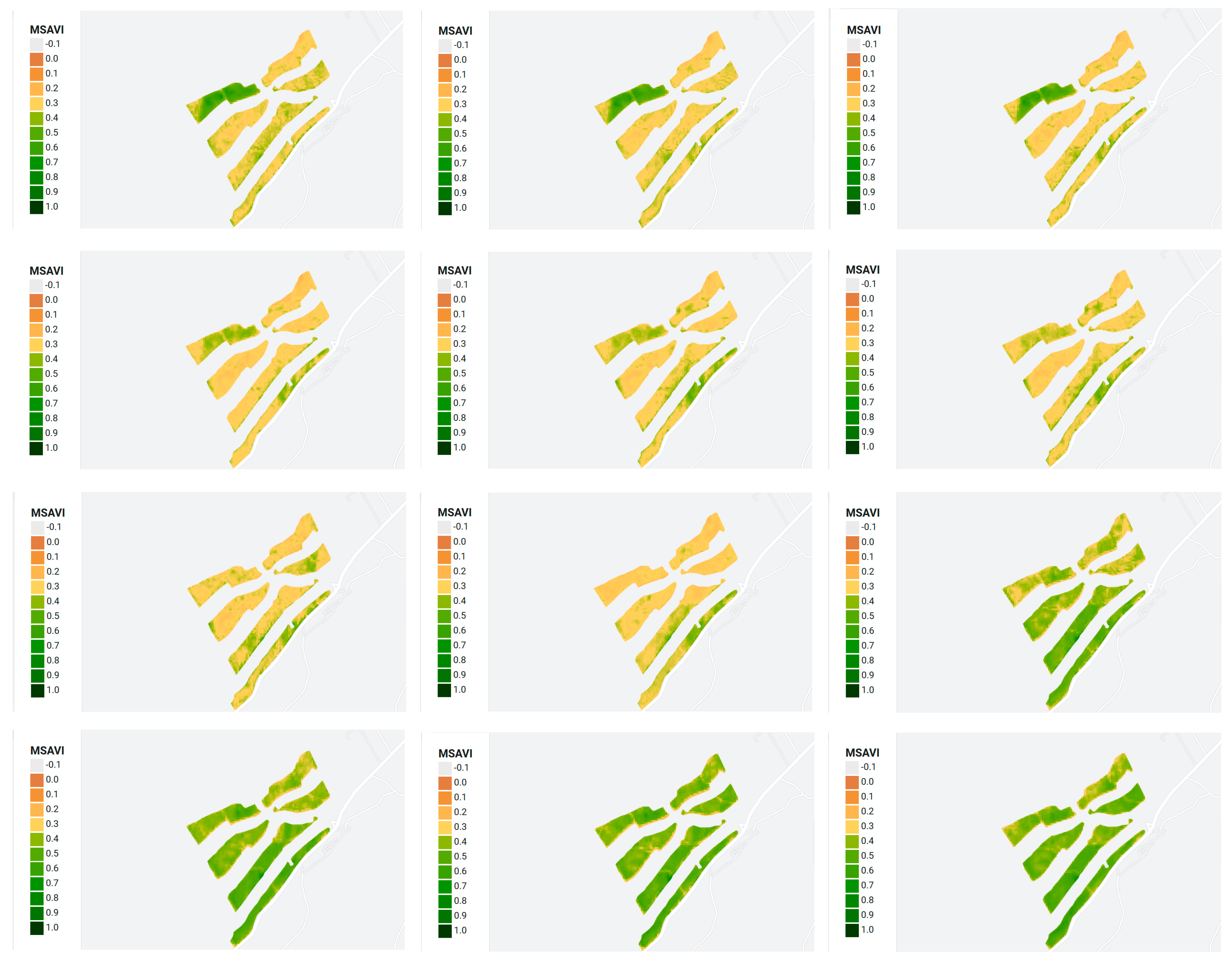
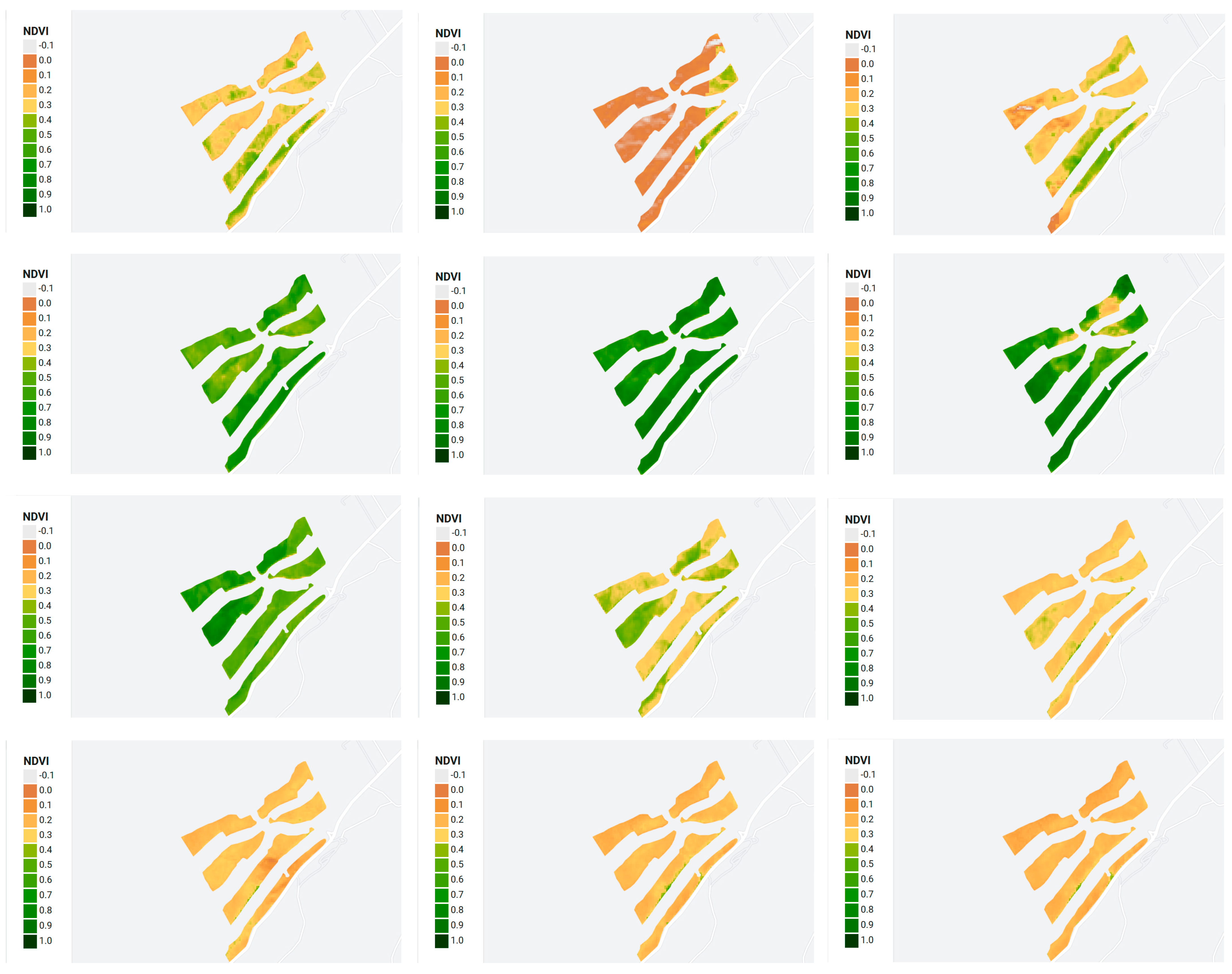
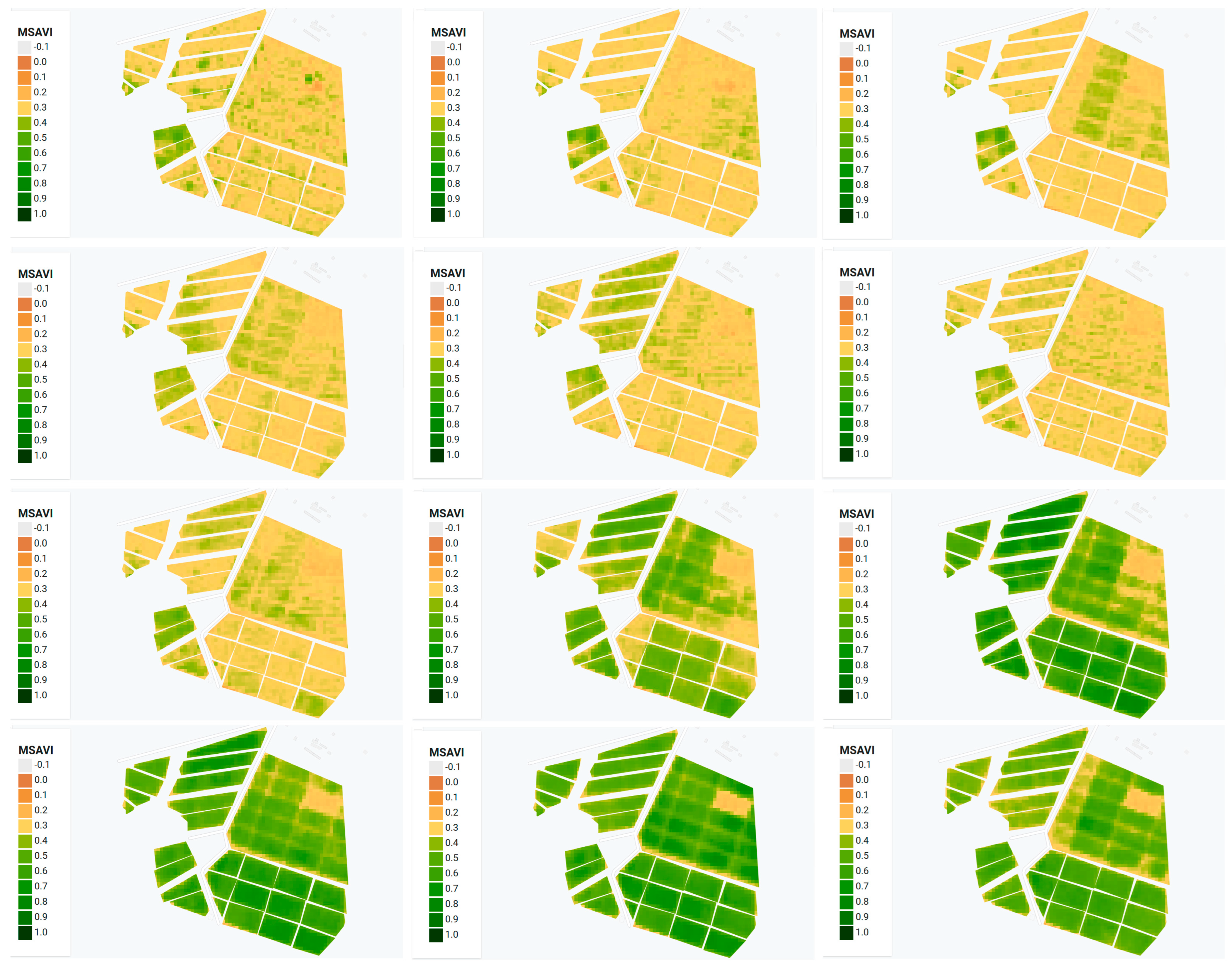
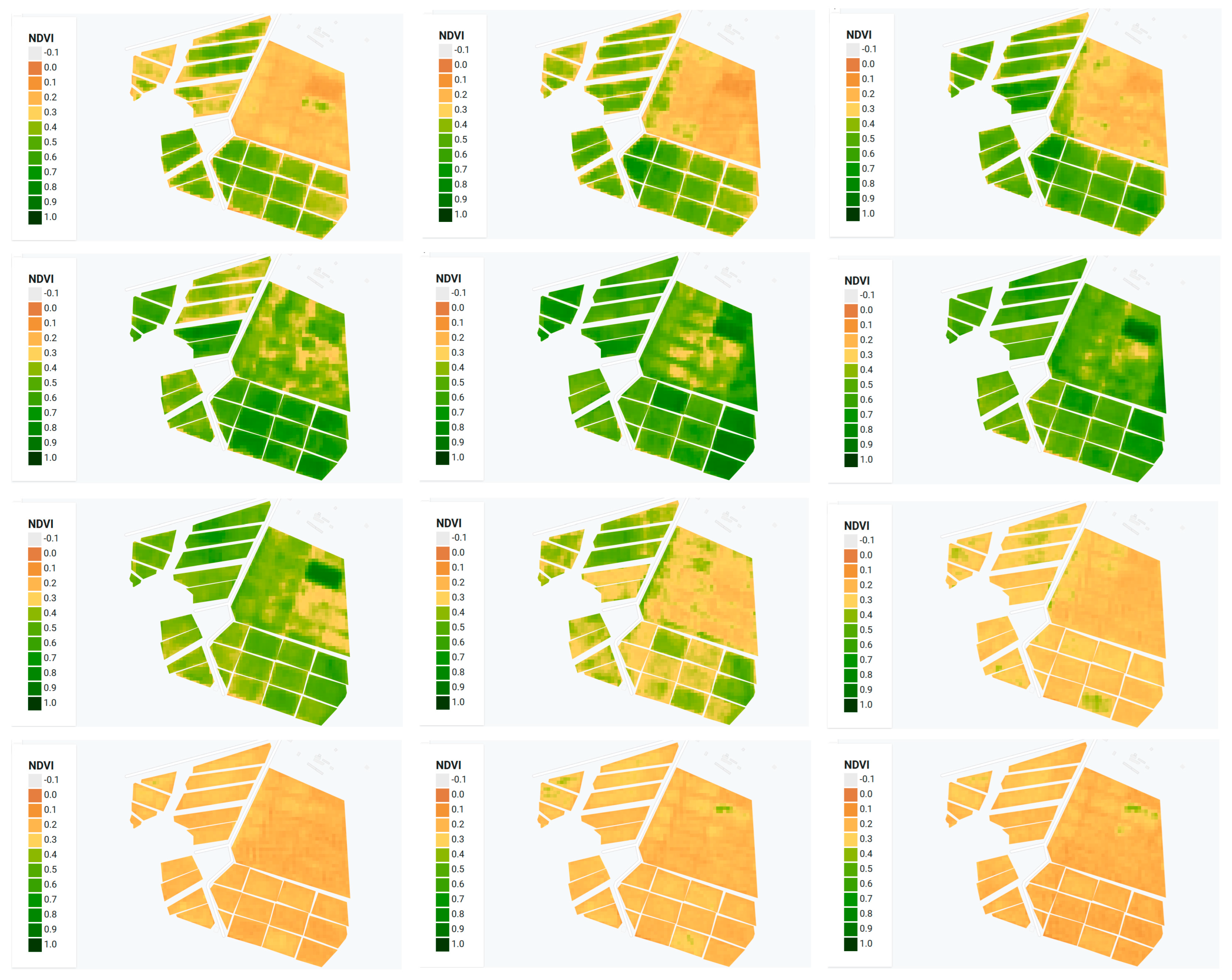
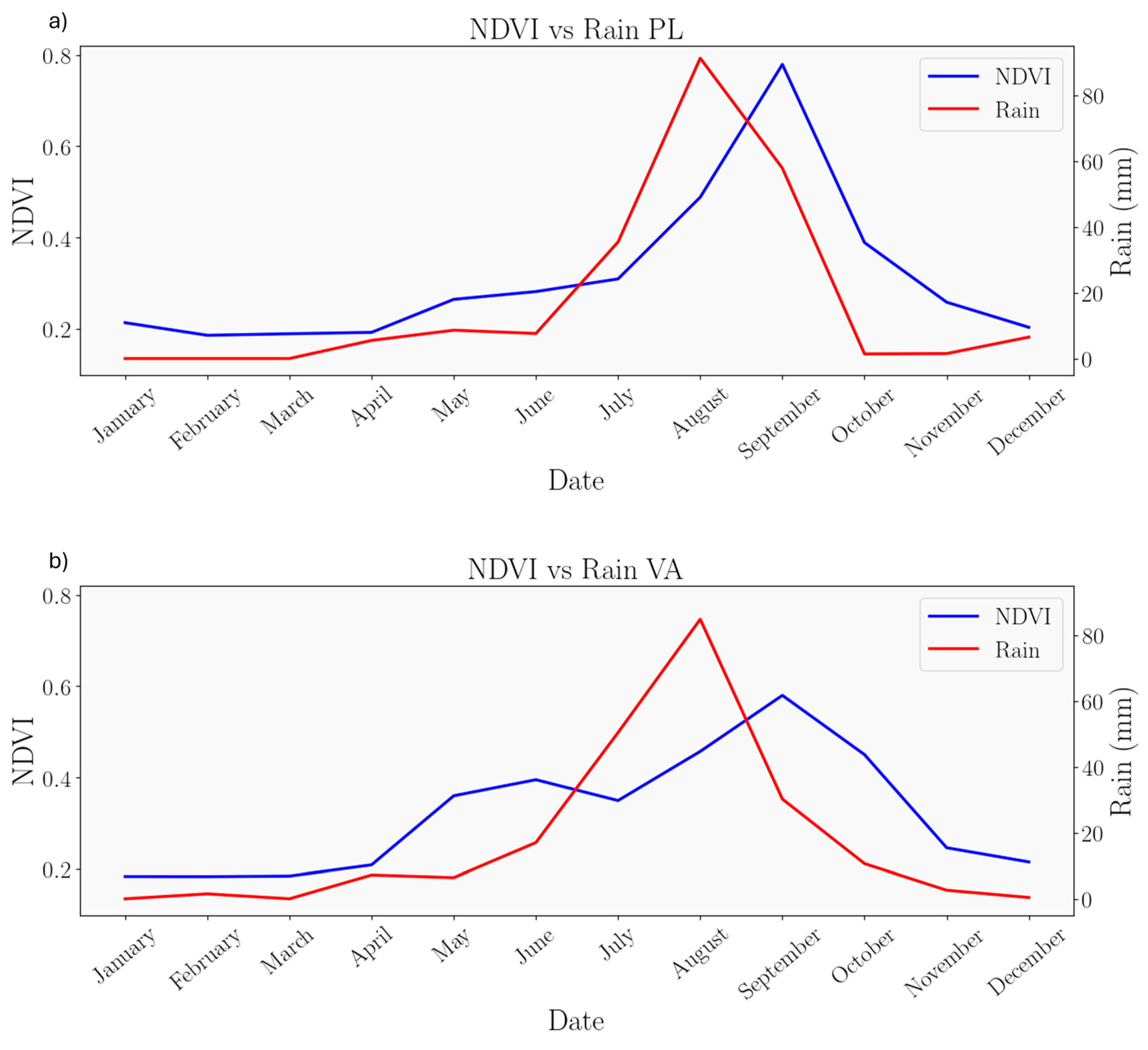
| Vineyard | Area (Ha) | Average Temperature (°C) | Annual Precipitation (mm) | Primary Soil | Secondary Soil | Altitude (masl) | Mean Slope |
|---|---|---|---|---|---|---|---|
| PL | 22.7 | 17.6 | 521.4 | Vertisol/Leptosol | Phaeozems | 1950 | 3.8° |
| VA | 23.8 | 17.5 | 472.5 | Vertisol | Vertisol | 1967 | 2.4° |
| PL | VA | |
|---|---|---|
| Pruning | 13 March 2022 | |
| Sprouting | 20 March 2022 | 21 March 2022 |
| First leaves appearance | 7 April 2022 | 1 April 2022 |
| Flowering | 2 May 2022 | 3 May 2022 |
| Veraison (50%) | 10 July 2022 | 8 July 2022 |
| Harvest | 19 August 2022 | 17 August 2022 |
| Browning of leaves | 17 October 2022 | 18 October 2022 |
| Value | Interpretation |
|---|---|
| <0.1 | Bare soil, water, or clouds |
| 0.1–0.2 | Almost absent canopy cover |
| 0.2–0.3 | Very low canopy cover |
| 0.3–0.4 | Low canopy cover with low vigour or very low canopy cover with high vigour |
| 0.4–0.5 | Mid-low canopy cover with low vigour or low canopy cover with high vigour |
| 0.5–0.6 | Average canopy cover with low vigour or mid-low canopy cover with high vigour |
| 0.6–0.7 | Mid-high canopy cover with low vigour or average canopy cover with high vigour |
| 0.7–0.8 | High canopy cover with high vigour |
| 0.8–0.9 | Very high canopy cover with very high vigour |
| 0.9–1.0 | Total canopy cover with very high vigour |
| Value | Interpretation |
|---|---|
| −1.0–0.2 | Bare soil |
| 0.2–0.4 | Seed germination stage |
| 0.4–0.6 | Leaf development stage |
| >0.6 | Vegetation is dense enough to cover the soil, use NDVI |
| Index | PL | VA | |
|---|---|---|---|
| Local Meteorological Stations | WI | 2020 °C Region IV | 1911 °C Region III |
| HI | 2541 °C Warm | 2442 °C Warm | |
| GST | 19.4° C Warm | 19.1 °C Warm | |
| CI | 12.4 °C Cold | 12.3 °C Cold | |
| Satellites | WI | 2019 °C Region IV | 1934 °C Region III |
| HI | 2652 °C Warm | 2654 °C Warm | |
| GST | 19.4 °C Warm | 19.0 °C Warm | |
| CI | 13.1 °C Cold | 13.2 °C Cold | |
| Average 2000–2022 | WI | Region III | Region III |
| HI | Warm | Warm | |
| GST | Temperate | Temperate | |
| CI | Cold | Cold |
Disclaimer/Publisher’s Note: The statements, opinions and data contained in all publications are solely those of the individual author(s) and contributor(s) and not of MDPI and/or the editor(s). MDPI and/or the editor(s) disclaim responsibility for any injury to people or property resulting from any ideas, methods, instructions or products referred to in the content. |
© 2024 by the authors. Licensee MDPI, Basel, Switzerland. This article is an open access article distributed under the terms and conditions of the Creative Commons Attribution (CC BY) license (https://creativecommons.org/licenses/by/4.0/).
Share and Cite
del Rio, M.S.; Cicuéndez, V.; Yagüe, C. Characterisation of Two Vineyards in Mexico Based on Sentinel-2 and Meteorological Data. Remote Sens. 2024, 16, 2538. https://doi.org/10.3390/rs16142538
del Rio MS, Cicuéndez V, Yagüe C. Characterisation of Two Vineyards in Mexico Based on Sentinel-2 and Meteorological Data. Remote Sensing. 2024; 16(14):2538. https://doi.org/10.3390/rs16142538
Chicago/Turabian Styledel Rio, Maria S., Victor Cicuéndez, and Carlos Yagüe. 2024. "Characterisation of Two Vineyards in Mexico Based on Sentinel-2 and Meteorological Data" Remote Sensing 16, no. 14: 2538. https://doi.org/10.3390/rs16142538
APA Styledel Rio, M. S., Cicuéndez, V., & Yagüe, C. (2024). Characterisation of Two Vineyards in Mexico Based on Sentinel-2 and Meteorological Data. Remote Sensing, 16(14), 2538. https://doi.org/10.3390/rs16142538








